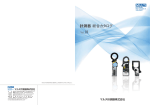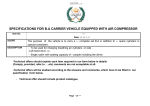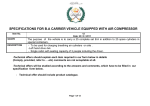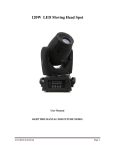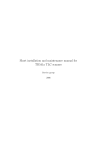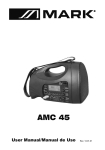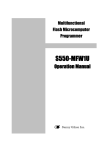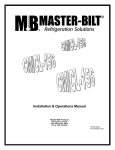Download Maxwell MX-25 302 User`s guide
Transcript
MX-25 302 User’s guide for 3 1/2 digits multimeter Description: 1.1 General description 2 Display: ½ digits liquid crystal display, with 26 mm characters max. displayable …1999 Polarity: Automatic negative polarity display Null: Automatic Measuring method: A/D converter Measurement rate: 3/seconds Overload Display: only the “1/-1” symbol is shown symbol is shown on the display Low Battery : the battery Security requirements: CE EMC/ LVD. The instrument corresponds to the IEC1010 standard. Designed to Protection Class II requirement : Double insulation Operating environment:0°...40 C°, relative humidity :<80% Storage Temperature: Temperature: -10 C°…+50 C°. relative humidity :<80% Battery: 9 V, IEC6F22 type battery Dimensions: 189mm×92,5mm×35mm Weight: 375g (with battery) Accessories: Users guide, instrument cable (red and black, 1 pair), Plastic case,K type Thermo sensor, 2 2.1 Electronic characteristics Punctuality +/- (displayed value’s rate(%) + the number of the digits) 23 +/-5 C°, if the humidity is lower than 75%. DC Voltage Measuring range 200 mV 2V 20 V 200 V 1000 V Accuracy +/- (0,5%+3) +/-(1,0%+5) Resolution 0,1 mV 1 mV 10 mV 100 mV 1V Input Impedance: 10 MΩ Overload Protection: 200 mV range : 250V DC/AC RMS 2-1000 V range : 1000 V DC/AC RMS AC Voltage Measuring range 2V 20 V 200 V 750 V Accuracy +/- (0,8%+5) +/-(1,2%+5) Resolution 1 mV 10 mV 100 mV 1V Input impedance: 2 V range:10 MΩ 20-700 V range :10MΩ Overload protection: 1000V DC/AC RMS Frequency range: 2-200 V range :40-400 Hz 750 V range :40-200 Hz Shown value : average rate (in case of RMS sinus sign) 3 Resistance Measuring range 200Ω 2Ω 20 Ω 200 Ω 2MΩ 200 M Ω Accuracy +/- (0,8%+5) +/-(5,0%(rdg-10) + 20) Resolution 0,1 Ω 1Ω 10 Ω 100 Ω 1kΩ 100 k Ω Accuracy +/- (0,8% + 3d) +/- (1,2% + 4d) +/- (2,0% + 5d) Resolution 10 uA 100 uA 10 mA +/- (0,8% + 3) output voltage : <3V Overload protection: 250 V DC/AC RMS DC Current Measuring range 20 mA 200 mA 20 A Max : 200 mV Max input current: 20A (maximum 10 seconds) Overload protection: 0,2 A/250 V “F” fusion 20A measuring range not ensured! 4 AC current Measuring range 20 mA 200 mA 20 A Accuracy +/- (1,0% +5) +/- (2,0% +5) +/- (3,0% +10) Resolution 10 uA 100 uA 10 mA Accuracy +/- (2,5% + 20) Resolution 10 pF 1 nF 100 nF Max. max measuring voltage:200 mV Max input current: 20 A (max: 10 seconds) Overload protection: 0,2 A/250 V “F”fusion 20 A measuring range not ensured! Frequency range :40-200 Hz Displayed value: general value (in case of RMS sinus signal) Capacity Measuring range 20 nF 20 uF 200 uF Measuring frequency: 150 Hz Overload protection: 36 V DC/AC RMS 5 Temperature Measuring range -40 C° – 1000 C° Accuracy +/- (1,0%+3) < 400 C° +/- (1,5%+15) > 400 C° Resolution 1 C° Description Open circuit voltage measurement Test mode Open circuit DC current approx. : 1mA Close circuit DC voltage 3V Output voltage 3 V With K type temperature sensor Diode Test Function A Sound indicates, if resistance between the V/Ohm and the COM is lower than 70Ω Overload protection: 250 V DC/AC RMS Warning: Don’t connect other power sources to the inputs ! Frequancy Measuring range Accuracy 2 kHz +/- (3,0%+15) 200 kHz Input sensibility: 1V RMS Overload Protection: 250 V DC/AC RMS (maximum for 15 seconds) Resolution 1 Hz 100 Hz 6 Transistor hfe” test Function hfe Description … the transistors electric power (0-1000) (All the types) Test mode Basis current around 10 uA V ce around 3V 2. Use of the device 1. Check the 9 V battery, turn Power On position. If the battery exhausted, the symbol appears on the display. 2. The signs next to the wires are showing, that the input voltage or current shouldn’t be higher than the correct value. In this way you can protect the internal circuits from the damages. 3. Please, turn the Function switch in to the right position(function). 4. If you don’t know the range of the measuring value, choose the largest range and do it backwards till you find the right one. 2.1 DC and AC voltage measurement 1. Connect the black wire to the “COM”, and the red wire to the “V/Ω/Hz plug. 2. Turn the Function switch in to the right V position and connect the wires parallel with the voltage source for the measuring time. 2.1.1 Phase searching function 1. Turn the Function switch to the “TEST” position, connect the red wire to the “V/Ω/Hz” socket. A sound and a(flash)light will indicate if there is phase. Note: a. If you don’t know the measured current range, turn the Function button in to choose the largest range and do it backwards till you find the right one by switching it down .If the “1” or the “-1” appear on the display, that means overload. In this case turn the Function switch into a higher measure range. b. Don’t connect higher then DC1000V/AC7000V RMS voltage to the input . c. Don’t touch the high voltage current during the measure. 7 2.2 Measure of DC and AC current 1. connect the black wire in to the “COM”, the red in to the “mA” (max . 200mA) or the “20A” wire for measuring 200mA – 20A. 2. Switch the Function button in to the right measure range. 3. Connect the wires tightly to the (DC/AC) source for the measure. 4. Between the measuring range of 200 mA and 10A ( current) connect the red wire to the “20A” to measure it. Note: a. If you don’t know the measured current range, turn the button to choose the largest range and do it backwards till you find the right one by switching down . b. If the “1” or the “-1” appear on the display, that means overload. In this case turn the Function button into a higher measure range. c. The max. input current is 200mA or 20A depends on the chosen input( the max. time for the test is 15 sec). If the current is higher, it can blow out the fusion. The 20A measure range is not ensured. 2.3 Resistance measure 1. Connect the black wire to the “COM”, and the red wire to the “V/Ω/Hz/C”port. 2. Switch the Function button to the desired resistance’s measure range. 3. Connect the wires parallel with the measurable circuit. Warning: make sure all the power of the circuit to be measured is off. Note: a. If the value of the measurable resistance over helming the value of the maximum measurable level, and if the instrument overloaded, (“1” or”1”) choose a higher measure range. Over 1MΩ resistances the instrument is stabilising the value of the resistor in a few seconds. This is absolutely normal in high value resistance measures. b. If you don’t connect resistance to the input (for ex. the circuit is splited ), the “1” or “-1” will appear because the over helming of the measure limit. If you are examining a resistance in a circuit, be sure that the circuit has all power removed and all capacitor are fully discharged. Don’t c. Don’t connect to the instrument any input voltage , because it can damage the integrated circuits. 8 2.4 Capacity measure 1. Set the function switch to the F position. 2. Connect the black test lead to the (-) jack „COM” and red lead to the (+) jack „mA”. 3. Connect test leads across the capacitor under measurement and be sure that the polarity of connection is observed. Note: 1. If the value of the measurable resistance over helming the value of the maximum measurable level, and if the instrument overloaded, (“1” or”1”) choose a higher measure range. 2. Unit: 1uF=103 nF 1nF=103 pF 3. When checking in-circuit capacitance, be sure that the circuit has all power removed and all capacitor are fully discharged(the electrolite capacitor shuold be discharged several times). 2.5 Diode and continuity check 1. Connect the black test lead to the COM and the red one to the V/Ω/Hz/C port (Note: the polarity of the red wire is +) mode. 2. Turn the Function switch to 3. Connect the leads to the outlet of the diode. Now you can see the open voltage of the diode on the display. 4. Touch two point of the circuit with the wires, a buzzer sounds when the resistance of the circuit to be measured is less than approx.70 Ω. Note: 1. If you don’t connect any unit to the ports the display will show “1” or “-1” 2. The current flowing through the diode during the test is 1 mA. 3. The display will show the open voltage in mV or “overload” if you switched the polarities. 2.6 Measuring Temperature 1. Set the Function switch to °C or to °F. 2. Put the sensor of the probe into the socket (pay attention to the polarity, it should be -) and put the other to the place of which the temperature you want to measure. On the display you will see the measured temperature in °C or °F. 9 Note: 1. This unit uses a special temperature measuring sensor. 2.7 Transistor hfe Test Turn the switch to hfe. 1. Connect the sensor to the COM and mA ports. 2. Put the transistor into the appropriate socket, depending on the transistor being NPN or PNP. 3. The display shows the current amplifying factor of the transistor IB= 10uA, VCE =3V. 2.8 Frequency measurement 1. Connect the instrument cable or shielded wire to the COM and to the V/Ω/Hz/C port. 2. Set the switch to “200kHz” and touch the source of the signal with the leads. Note: 1. Do not try to measure the frequency when the voltage is more than 250V (RMS) 2. In noisy environment use shielded cable when measuring low signals 3. Do not touch the circuit when measuring high voltage 2.9 Freezing the display 1. Press the HOLD button to freeze the display with the current data, press the hold again to turn it back to measurement mode. 3. Automatic stand-by mode 1. 15 minutes after the latest measurement the unit will switch to stand-by mode 2. To turn it on again press the POWER button 10 4. Warning 1. When measuring 32 V DC / 25 V AC be sure that no cables are connected to the current measuring socket and the main switch is not in diode or resistor testing mode.Always make sure that you connected the cable to the right socket for its voltage. 2. Be cautious when measuring voltage higher than 50V, especially in the case of high current. 3. Do not connect the unit to “live” circuits. 4. When measuring current, turn off the voltage before you connect the multimeter. Do not try to measure current that is higher than 20A. 5. When testing the diode or the resistor, turn off the voltage before you start the test. 6. Always select the function and measuring range appropriate for the task. If you are unsure choose the largest range and do it backwards till you find the right one. 7. Make sure that the instrument wire and the insulation is intact. 8. Be cautious, do not exceed the overload range found in this manual. 9. When switching a fuse replace it with ratings specified. 10. When switching the fuse or changing the battery turn off the multimeter and disconnect every circuit before opening the case of the device 5. maintenance of the multiemter 1. Keep the multimeter dry, if it gets wet switch it off and dry it immediately. Liquids could corrode the circuits inside the unit. 2. Use the multimeter only in normal temperature, if the temperature gets too high it could shorten the lifetime of the device and can damage batteries and melt plastic parts. 3. Be careful with the unit. If you drop it, it can damage the multimeter and the case which can cause malfunction. 4. Keep the device away from dust, it can significantly shorten the lifetime of the multimeter. 5. You can clean the unit with a clean wet towel, do not use any cleaning liquids or acids. 11 4.2 Servicing the device 1. Changing the battery (one 9V battery is required) a. Switch off the unit and disconnect every external circuit. Disconnect the instrument cable from the socket. b. Remove the screws then the cover on the bottom side. c. Remove the flat battery and insert a new one from of same type ( Standard 9V battery). 2. Switching a fuse (5x20 mm ,200 mA / 250 V “F” labeled fused are used) a. Switch off the unit and disconnect every external circuit. Disconnect the instrument cable from the socket. b. Remove the screws then the cover on the bottom side. c. Replace the melted fuse with a new one from the same level and type . 12












